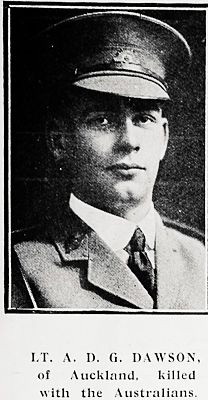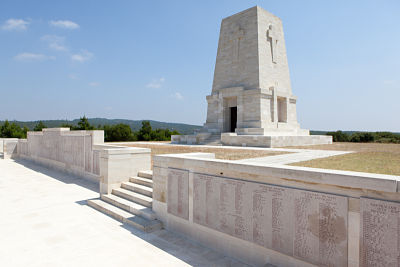WW1 Second Lieutenant Alan (Allan) Douglas Gibb Dawson (New Zealand Territorial Force 13/46, Australian Imperial Force (AIF) B 2455)
Alan (Allan) Douglas Gibb Dawson (New Zealand Territorial Force 13/46, Australian Imperial Force (AIF) B 2455) was born on 18 August 1891 in Sydney, the son of Alexander Robertson (Robinson) Dawson and Margaret Annie Dawson.
Alan came to New Zealand with his father when he was 8 years old, lived at 45 Shelly Beach Road, Ponsonby, Auckland; his mother remained in Australia and lived at ‘The Avon’, 11 Ocean Beach, Manly, Sydney. Alan attended Auckland Grammar School from 1906 to 1910. He was a champion swimmer; shooter, in the first fifteen rugby team and a Prefect in his last year there. He was a member of the College Rifles Rugby Football Club in Remuera which formed cadet units as part of the Territorials. [1]
He spent five years with the Auckland Grammar School Cadets reaching a rank of lieutenant. At Auckland Grammar School, cadet training had been compulsory for its students since 1899. The headmaster at the time, James William Tibbs, believed that those whom the State was educating should make themselves able to defend the State. [2] The organisation of the Cadet forces was integrated with the existing class structure. Classes became divisions, teachers and other staff became officers, and prefects became N.C.O.’s. Together, the school formed a complete battalion, and would even stage regular parades. [3] After leaving school, Alan worked as a law clerk, passing his University matriculation and solicitors’ general knowledge examination on the entrance scholarship papers in 1911.[4]
He attended Auckland University College (now The University of Auckland) studying jurisprudence and constitutional history and Classics and passing in 1911 – 1912. Alan spent a year with the Auckland Signalling Corps. Signallers enabled military units to communicate by using flags (semaphores), operating signalling lamps, laying telephone lines and using wireless radios. Sections were attached to Army divisions, serving in all theatres of war. [5] Alan was also in the Auckland Senior Cadets and in December 1911, he joined a newly formed company, 30th Company Auckland Senior Cadets in Ponsonby. The cadet system helped ensure that a ready supply of replacement officers and men was available for the New Zealand Expeditionary Force (NZEF) overseas. More than 8000 boys enrolled annually in the cadets between 1914 and 1918. They helped provide 10,000 new territorial soldiers each year, the majority of whom transferred to the NZEF. [6]
He joined the New Zealand Territorials and was promoted to 2nd Lieutenant on 15 January 1912, but on the 12 November 1914 Alan resigned from the New Zealand Territorials and accepted a commission on 20 November 1914 with the 2nd Battalion, Australian Imperial Force (AIF) as a 2nd Lieutenant. He embarked for Egypt on 22 December 1914 on the vessel ‘Themistocles’ . On 25 April 1915, New Zealand and Australian troops made their first major effort of the First World War during the Allied invasion of the Gallipoli Peninsula. Allied forces landed on Anzac Cove where British (and later French) forces made the main landing at Cape Helles on the southern tip of Gallipoli, while the Australian and New Zealand Army Corps (ANZAC) landed midway up the peninsula. Sent 2 km north of their intended landing place, they encountered determined Ottoman forces in the rugged country above the beach (soon known as Anzac Cove). Unable to make any significant advance, the Anzacs spent the next few days desperately holding onto their small beachhead. [7]
Alan Douglas Gibb Dawson (New Zealand Territorial Force 13/46, Australian Imperial Force (AIF) B 2455) became one of the many who lost their life that day. Alan was awarded the 1914-1915 Star, British War Medal (1914-1920) and the Victory Medal. He was 22 years old when he died on the 25th April 1915.
There is an obituary to him in the Auckland Grammar School Chronicle, 1915 p. 10-11 and memorials to him at: Lone Pine Memorial, Lone Pine Cemetery, Anzac, Turkey; Auckland Grammar School War Memorial, Auckland; and on the Roll of Honour, College Rifles, Rugby Union Football and Sports Club, 33 Haast Street, Remuera.


